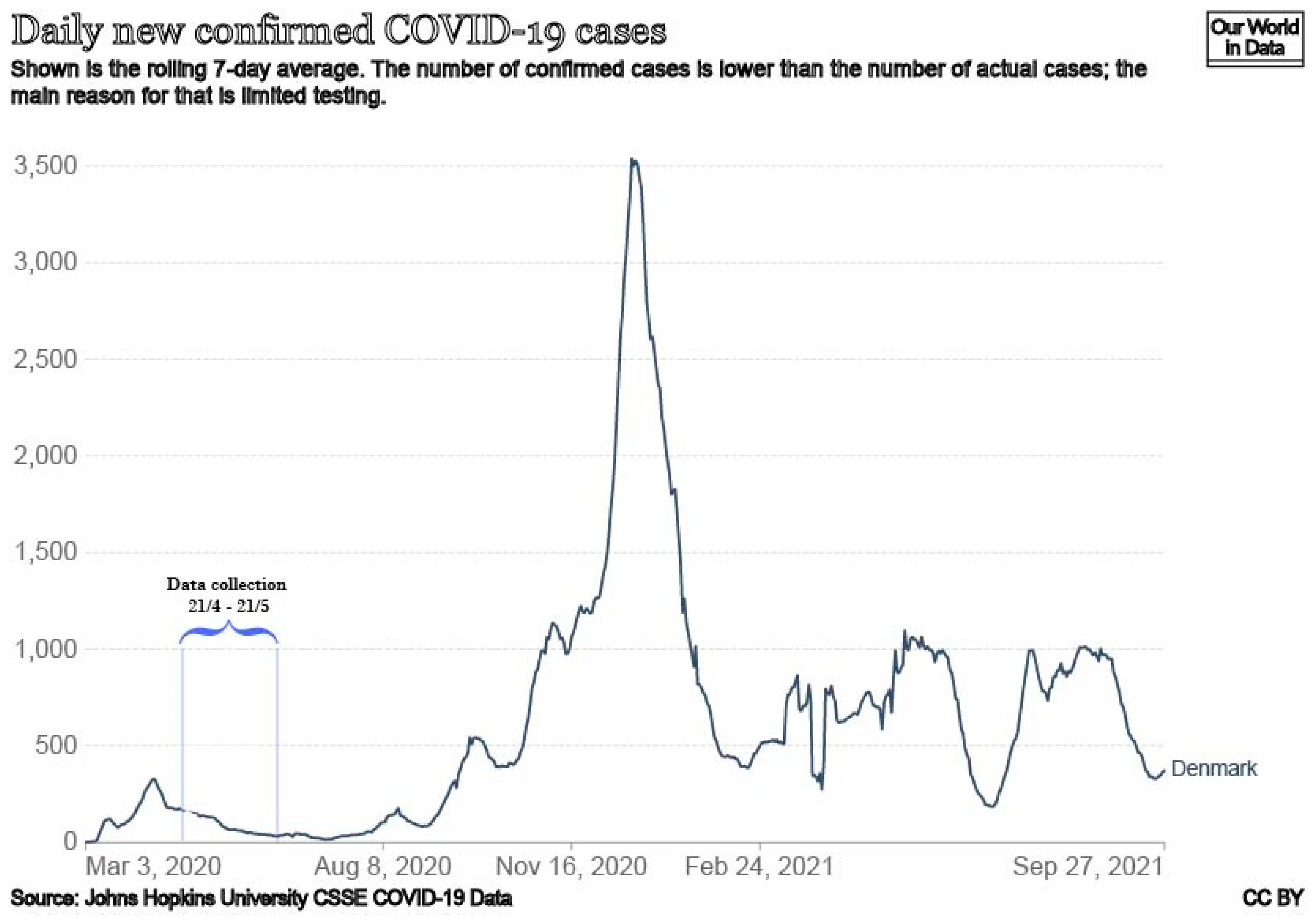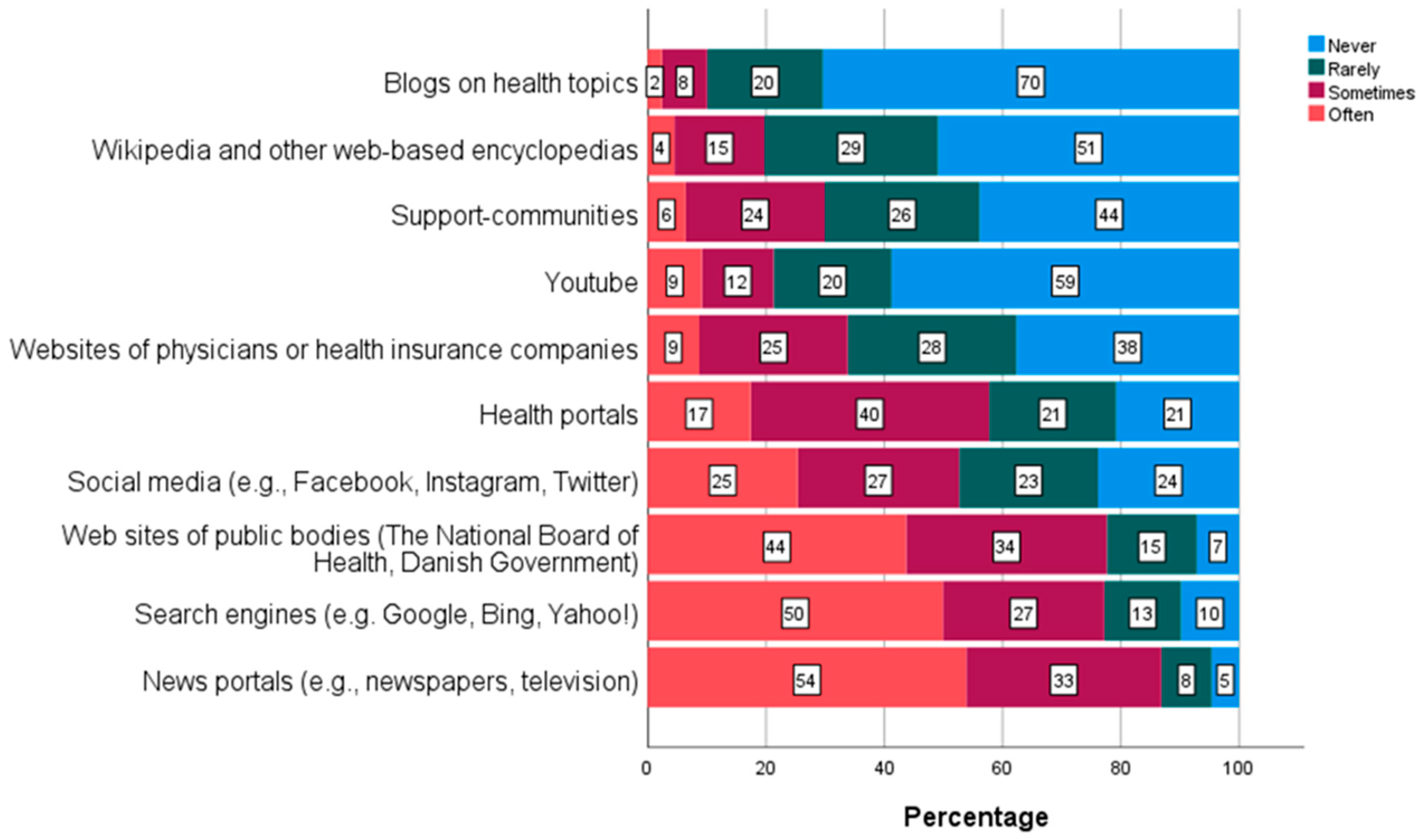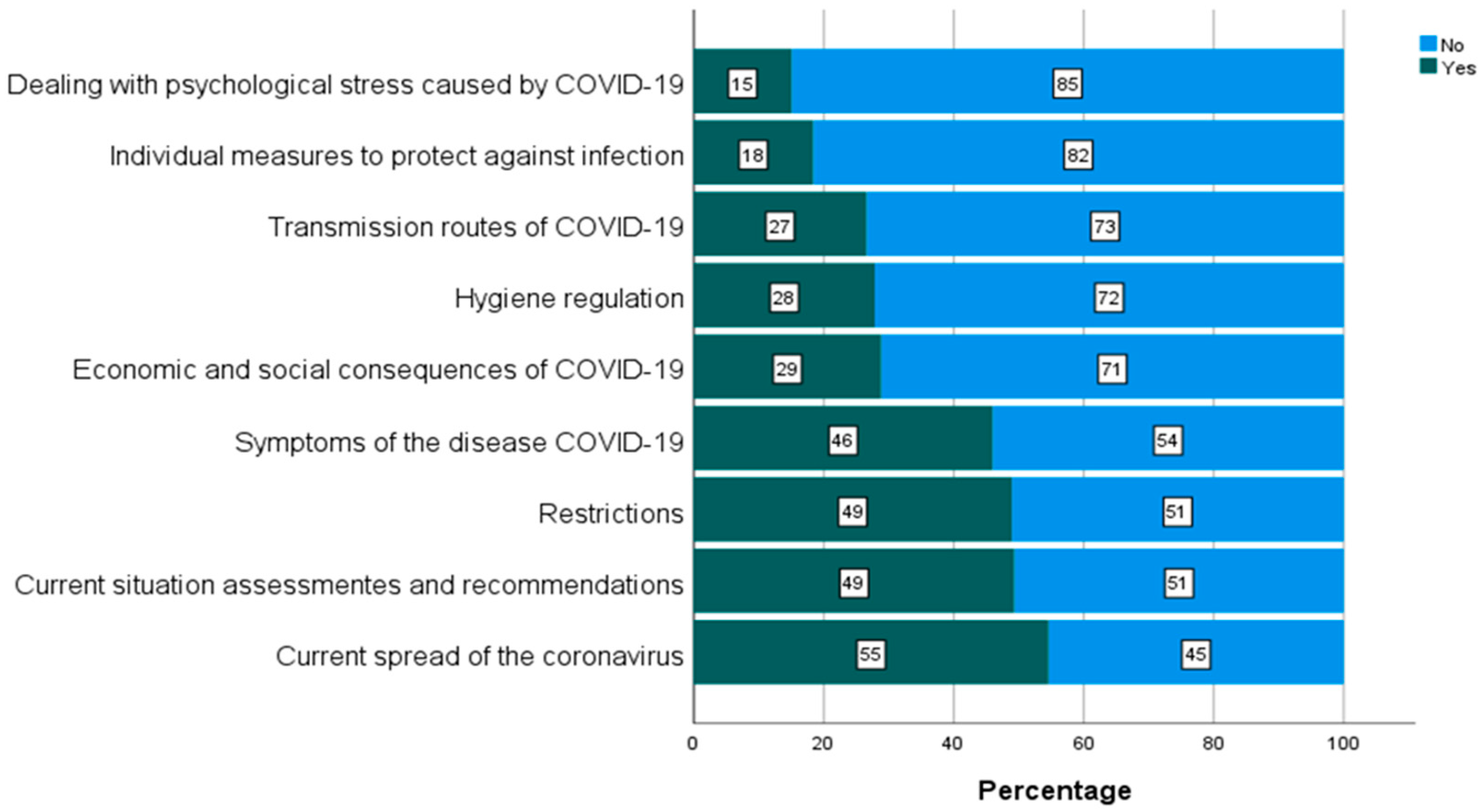Digital Health Literacy and Information-Seeking Behavior among University College Students during the COVID-19 Pandemic: A Cross-Sectional Study from Denmark
Abstract
:1. Introduction
- DHL across social characteristics such as subjective social status, gender, age, and education;
- The preferred sources, platforms, and topics for seeking information on COVID-19;
- How students judge the validity and sufficiency of the information they encounter;
- Use of social media and DHL among students;
- The association of social networks and DHL among students.
2. Methods
2.1. Study Design and Target Group
2.2. Participants—Recruitment and Distribution
2.3. Measures
2.3.1. Social Characteristics and Economic Variables
2.3.2. Digital Health Literacy Questionnaire
- Searching and finding health information on the internet,
- Creating and sharing of health information on the internet,
- Assessment of the quality of health information on the internet,
- Determining the everyday relevance of health information on the internet, and
- Handling of personal information and data protection on the internet.
2.3.3. Statistical Analyses
2.3.4. Ethical Considerations
3. Results
3.1. Across Social Characteristics
Preferred Sources, Platforms and Topics for Information Seeking
3.2. Ability to Find Information
3.3. Support from Social Network and Sharing of Health Information
4. Discussion
5. Conclusions
Author Contributions
Funding
Institutional Review Board Statement
Informed Consent Statement
Data Availability Statement
Acknowledgments
Conflicts of Interest
References
- Okan, O.; Bollweg, T.M.; Berens, E.-M.; Hurrelmann, K.; Bauer, U.; Schaeffer, D. Coronavirus-Related Health Literacy: A Cross-Sectional Study in Adults during the COVID-19 Infodemic in Germany. Int. J. Environ. Res. Public Health 2020, 17, 5503. [Google Scholar] [CrossRef] [PubMed]
- Sørensen, K. Covid-19: Digital Health Literacy Is A Key To Saving Time, Costs And Lives [Internet]; ICT&Health: Ewijk, The Netherlands, 2020; Available online: https://www.ictandhealth.com/news/covid-19-digital-health-literacy-is-a-key-to-saving-time-costs-and-lives/ (accessed on 6 October 2020).
- Paakkari, L.; Okan, O. COVID-19: Health literacy is an underestimated problem. Lancet Public Health 2020, 5, e249–e250. [Google Scholar] [CrossRef]
- Dwivedi, Y.K.; Hughes, D.L.; Coombs, C.; Constantiou, I.; Duan, Y.; Edwards, J.S.; Gupta, B.; Lal, B.; Misra, S.; Prashant, P.; et al. Impact of COVID-19 pandemic on information management research and practice: Transforming education, work and life. Int. J. Inf. Manag. 2020, 55, 102211. [Google Scholar] [CrossRef]
- Sentell, T.; Vamos, S.; Okan, O. Interdisciplinary Perspectives on Health Literacy Research Around the World: More Important Than Ever in a Time of COVID-19. Int. J. Environ. Res. Public Health 2020, 17, 3010. [Google Scholar] [CrossRef] [PubMed]
- Rothkopf, D.J. When the Buzz Bites Back [Internet]. Available online: http://www1.udel.edu/globalagenda/2004/student/readings/infodemic.html (accessed on 6 October 2020).
- Okan, O.; Messer, M.; Levin-Zamir, D.; Paakkari, L.; Sørensen, K. Health literacy as a social vaccine in the COVID-19 pandemic. Health Promot. Int. 2022, daab197. [Google Scholar] [CrossRef] [PubMed]
- Abel, T.; McQueen, D. Critical health literacy and the COVID-19 crisis. Health Promot Int. 2020, daaa040. [Google Scholar] [CrossRef] [PubMed]
- Navigating the ‘Infodemic’: How People in Six Countries Access and Rate News and Information about Coronavirus [Internet]; Reuters Institute for the Study of Journalism. Available online: https://reutersinstitute.politics.ox.ac.uk/infodemic-how-people-six-countries-access-and-rate-news-and-information-about-coronavirus (accessed on 6 October 2020).
- Ashrafi-Rizi, H.; Kazempour, Z. Information Diet in Covid-19 Crisis; A Commentary. Arch. Acad. Emerg. Med. 2020, 8, e30. [Google Scholar] [PubMed]
- Zarocostas, J. How to fight an infodemic. Lancet 2020, 395, 676. [Google Scholar] [CrossRef]
- Sørensen, K.; Van den Broucke, S.; Fullam, J.; Doyle, G.; Pelikan, J.; Slonska, Z.; Brand, H.; (HLS-EU) Consortium Health Literacy Project European. Health literacy and public health: A systematic review and integration of definitions and models. BMC Public Health 2012, 12, 80. [Google Scholar] [CrossRef] [PubMed] [Green Version]
- Sørensen, K.; Pelikan, J.M.; Röthlin, F.; Ganahl, K.; Slonska, Z.; Doyle, G.; Fullam, J.; Kondilis, B.; Agrafiotis, D.; Uiters, E.; et al. Health literacy in Europe: Comparative results of the European health literacy survey (HLS-EU). Eur. J. Public Health 2015, 25, 1053–1058. [Google Scholar] [CrossRef] [Green Version]
- Patil, U.; Kostareva, U.; Hadley, M.; Manganello, J.A.; Okan, O.; Dadaczynski, K.; Massey, P.M.; Agner, J.; Sentell, T. Health Literacy, Digital Health Literacy, and COVID-19 Pandemic Attitudes and Behaviors in U.S. College Students: Implications for Interventions. Int. J. Environ. Res. Public Health 2021, 18, 3301. [Google Scholar] [CrossRef] [PubMed]
- Li, S.; Cui, G.; Kaminga, A.C.; Cheng, S.; Xu, H. Associations between health literacy, ehealth literacy, and covid-19–related health behaviors among Chinese college students: Cross-sectional online study. J. Med. Internet Res. 2021, 23, e25600. [Google Scholar] [CrossRef] [PubMed]
- Hong, K.J.; Park, N.L.; Heo, S.Y.; Jung, S.H.; Lee, Y.B.; Hwang, J.H. Effect of e-health literacy on COVID-19 Infection-preventive behaviors of undergraduate students majoring in healthcare. Healthcare 2021, 9, 573. [Google Scholar] [CrossRef] [PubMed]
- McCaffery, K.; Dodd, R.; Cvejic, E.; Ayre, J.; Batcup, C.; Isautier, J.; Copp, T.; Bonner, C.; Pickles, K.; Nickel, B.; et al. Health literacy and disparities in COVID-19–related knowledge, attitudes, beliefs and behaviours in Australia. Public Health Res. Pract. 2020, 30, 30342012. [Google Scholar] [CrossRef] [PubMed]
- Okan, O.; Bollweg, T.M.; Bauer, U.; Hurrelmann, K.; Janner, C.; Schaeffer, D. Corona-Specific Health Literacy in Germany: Second Survey of the HLS-COVID-19 Trend Study; English Summary Report; Interdisciplinary Centre for Health Literacy Research; Bielefeld University: Bielefeld, Germany, 2021. [Google Scholar] [CrossRef]
- Rosário, R.; Martins, M.R.O.; Augusto, C.; Silva, M.J.; Martins, S.; Duarte, A.; Fronteira, I.; Ramos, N.; Okan, O.; Dadaczynski, K. Associations between COVID-19-Related Digital Health Literacy and Online Information-Seeking Behavior among Portuguese University Students. Int. J. Environ. Res. Public Health 2020, 17, 8987. [Google Scholar] [CrossRef]
- Dadaczynski, K.; Okan, O.; Messer, M.; Leung, A.Y.M.; Rosário, R.; Darlington, E.; Rathmann, K. Digital Health Literacy and Web-Based Information-Seeking Behaviors of University Students in Germany During the COVID-19 Pandemic: Cross-sectional Survey Study. J. Med. Internet Res. 2021, 23, e24097. [Google Scholar] [CrossRef]
- Dodd, R.H.; Dadaczynski, K.; Okan, O.; McCaffery, K.J.; Pickles, K. Psychological Wellbeing and Academic Experience of University Students in Australia during COVID-19. Int. J. Environ. Res. Public Health 2021, 18, 866. [Google Scholar] [CrossRef]
- Leung, A.Y.M.; Parial, L.L.; Tolabing, M.a.C.; Sim, T.; Mo, P.; Okan, O.; Dadaczynski, K. Sense of coherence mediates the relationship between digital health literacy and anxiety about the future in aging population during the COVID-19 pandemic: A path analysis. Aging Ment. Health 2021, 26, 544–553. [Google Scholar] [CrossRef]
- Vrdelja, M.; Vrbovšek, S.; Klopčič, V.; Dadaczynski, K.; Okan, O. Facing the Growing COVID-19 Infodemic: Digital Health Literacy and Information-Seeking Behaviour of University Students in Slovenia. Int. J. Environ. Res. Public Health 2021, 18, 8507. [Google Scholar] [CrossRef]
- Dadaczynski, K.; Okan, O.; Rathmann, K. COVID-19 Health Literacy Survey: University Students (COVID-HL-Survey). Questionnaire and Scale Documentation [Internet]. 2020. Available online: https://pub.uni-bielefeld.de/record/2942920 (accessed on 6 October 2020).
- Schricker, J.; Rathmann, K.; Dadaczynski, K. Soziale Unterschiede in der Gesundheitskompetenz von Studierenden: Ergebnisse einer Online-Studie an der Technischen Universität Dortmund. Prävent Gesundh. 2020, 15, 8–14. [Google Scholar] [CrossRef]
- Abreu, L.; Arriscado-Nunes, J.; Taylor, P.; Silva, S. The Role of Distributed Health Literacy in Asthma Integrated Care: A Public Medical Context from Portugal. Int. J. Integr. Care 2018, 18, 18. [Google Scholar] [CrossRef] [PubMed] [Green Version]
- Sentell, T.; Agner, J.; Pitt, R.; Davis, J.; Guo, M.; McFarlane, E. Considering Health Literacy, Health Decision Making, and Health Communication in the Social Networks of Vulnerable New Mothers in Hawai‘i: A Pilot Feasibility Study. Int. J. Environ. Res. Public Health 2020, 17, 2356. [Google Scholar] [CrossRef] [Green Version]
- Edwards, M.; Wood, F.; Davies, M.; Edwards, A. ‘Distributed health literacy’: Longitudinal qualitative analysis of the roles of health literacy mediators and social networks of people living with a long-term health condition. Health Expect Int. J. Public Particip. Health Care Health Policy 2015, 18, 1180–1193. [Google Scholar] [CrossRef] [PubMed] [Green Version]
- Mckinn, S.; Duong, L.; Foster, K.; Mccaffery, K. Distributed Health Literacy in the Maternal Health Context in Vietnam. HLRP Health Lit. Res. Pract. 2019, 3, e31–e42. [Google Scholar] [CrossRef] [PubMed] [Green Version]
- Hoebel, J.; Müters, S.; Kuntz, B.; Lange, C.; Lampert, T. Measuring subjective social status in health research with a German version of the MacArthur Scale. Bundesgesundheitsblatt Gesundheitsforschung Gesundheitsschutz. 2015, 58, 749–757. [Google Scholar] [CrossRef] [PubMed] [Green Version]
- van der Vaart, R.; Drossaert, C. Development of the Digital Health Literacy Instrument: Measuring a Broad Spectrum of Health 1.0 and Health 2.0 Skills. J. Med. Internet Res. 2017, 19, e27. [Google Scholar] [CrossRef] [PubMed] [Green Version]
- Cohen, J. Statistical Power Analysis for the Behavioral Sciences, 2nd ed.; Hillsdale, N.J., Ed.; Lawrence Erlbaum Associates Inc.: Mahwahm NJ, USA, 1988; p. 567. [Google Scholar]



| Questions | Response Options | |
|---|---|---|
| q 15 | “When you search the internet for information on the corona virus or related topics, how easy or difficult is it for you to… ”: - make a choice from all the information you find? - use the proper words or search query to find the information you are looking for? - find the exact information you are looking for? | The response options were on a four-point Likert scale (1) very difficult, (2) difficult, (3) easy, and (4) very easy) |
| q 16 | “When you post a message (e.g., on a forum or social media like Facebook or Twitter) about coronavirus or similar topics, how ‘easy’ or ‘difficult’ is it for you to…” - articulate your question or health-related concern clearly? - express your attitude, thoughts, or feelings in writing? - write your message in a way so that people understand exactly what you mean? | The response options were on a four-point Likert scale (1) very difficult, (2) difficult, (3) easy, and (4) very easy) |
| q 17 | “When you search the internet for information on the corona virus or related topics, how easy or difficult is it for you to … ” -check different websites to see whether they provide the same information -decide whether the information is written with commercial interests (e.g., by people trying to sell a product) -decide whether the information is reliable or not | The response options were on a four-point Likert scale (1) very difficult, (2) difficult, (3) easy, and (4) very easy) |
| q 18 | “When you search the internet for information on coronavirus or similar topics, how ‘easy’ or ‘difficult’ is it for you to…” … assess whether the information is useful to you? … use the information you find in your everyday life? … use the information you found to make decisions about your health (e.g., protective measures, hygiene regulations, routes of infection, risks and risk prevention) | The response options were on a four-point Likert scale (1) very difficult, (2) difficult, (3) easy, and (4) very easy) |
| Assessment of social network | ||
| q 25 | “Do you use your knowledge and skills to help others in your close relationships (e.g., friends, family) to find and understand health information from the internet?” | Yes, I help with finding and understanding relevant information (e.g., about diseases, health issues, and COVID-19) -Yes, I help with advice about, e.g., healthy lifestyle in everyday life (e.g., smoking, nutrition, alcohol, physical activity, and stress/mental well-being) -Yes, I help with assessment of the reliability of health information from authorities (e.g., government, the National Board on Health, region, and municipalities) -No -Not relevant Multiple answers were possible |
| q 26 | “Do you use your knowledge and skills to help others in your close relationships (e.g., friends, family) to find and understand health information from the internet?” |
|
| Characteristics | Total | Female | Male |
|---|---|---|---|
| Participants n (%) | n = 1518 | n = 1266 | n = 247 |
| Age (years, mean) | 28.4 (SD 8.4) | 28.3 (SD 8.4) | 28.9 (SD 8.1) |
| Age group | |||
| <26 | 822 (54.2) | 703 (55.5) | 115 (46.6) |
| 26–30 | 287 (18.9) | 220 (17.4) | 66 (26.7) |
| >30 | 409 (26.9) | 343 (27.1) | 66 (26.7) |
| Study course | n = 1511 (div n = 5) | n = 1262 | n = 244 |
| Education (BA) | 751 (49.5) | 608 (48.2) | 140 (57.4) |
| Health | 470 (31.0) | 415 (32.9) | 55 (22.5) |
| Society and administration | 264 (17.5) | 222 (17.6) | 40 (16.4) |
| Other (vocational diploma? EVU) | 26 (1.7) | 17 (1.3) | 9 (3.7) |
| Subjective social status n (%) | n = 1446 (div n = 5) | n = 1207 | n = 234 |
| Low | 364 (24.0) | 288 (23.9) | 72 (30.8) |
| Medium | 952 (62.7) | 808 (66.9) | 143 (61.1) |
| High | 130 (8.6) | 111 (9.2) | 19 (8.1) |
| Level of DHL (excl DHL privacy) | n = 1005 | n = 845 | n = 157 |
| Sufficient DHL | 592 (59.9) | 488 (57.8) | 101 (64.3) |
| Limited DHL | 413 (41.1) | 357 (42.2) | 56 (35.7) |
| Characteristics | Very Easy/Easy | Difficult/Very Difficult |
|---|---|---|
| Information search | ||
| Make a choice from all the information you find (n = 1106) | 84.8 | 15.2 |
| Use the proper words/search query to find the information you are looking for (n = 1106) | 92.7 | 7.3 |
| Find the exact information you are looking for (n = 1106) | 82 | 18 |
| Adding self-generated content | ||
| Clearly formulate a question (n = 1106) | 83.4 | 16.6 |
| Express opinions, thoughts or feelings in writing (n = 1106) | 76 | 24 |
| Write your message so it can be understood as you intend (n = 1106) | 74.4 | 25.6 |
| Evaluating reliability | ||
| Decide whether the information is reliable or not (n = 1106) | 71.9 | 28.1 |
| Decide whether the information is written with commercial interests (n = 1106) | 79.2 | 20.8 |
| Check different websites to see whether they provide the same information (n = 1106) | 83 | 17 |
| Determining relevance | ||
| Decide whether the information is applicable (n = 1106) | 89.1 | 10.9 |
| Apply the information in daily life (n = 1106) | 87.3 | 12.7 |
| Use information to make health-related decisions (n = 1106) | 86.2 | 13.8 |
| Do You Get Help from Your Close Relationships (e.g., Friends, Family, Classmates) to Find Information about COVID-19? | Overall DHL (Excl Privacy) | ||||
|---|---|---|---|---|---|
| Limited, n (%) | Sufficient, n (%) | X2 (df) | p | V | |
| Yes | 222 (46.4) | 256 (53.6) | 9.81 (1) | 0.002 | 0.11 |
| No | 128 (35.7) | 231 (64.3) | |||
| Yes, often | 32 (55.2) | 26 (44.8) | 11.95 (3) | 0.008 | 0.12 |
| Yes, sometimes | 109 (44.7) | 135 (55.3) | |||
| Yes, but rarely | 81 (46) | 95 (54) | |||
| No | 128 (35.7) | 231 (64.3) | |||
Publisher’s Note: MDPI stays neutral with regard to jurisdictional claims in published maps and institutional affiliations. |
© 2022 by the authors. Licensee MDPI, Basel, Switzerland. This article is an open access article distributed under the terms and conditions of the Creative Commons Attribution (CC BY) license (https://creativecommons.org/licenses/by/4.0/).
Share and Cite
Bak, C.K.; Krammer, J.Ø.; Dadaczynski, K.; Orkan, O.; von Seelen, J.; Prinds, C.; Søbjerg, L.M.; Klakk, H. Digital Health Literacy and Information-Seeking Behavior among University College Students during the COVID-19 Pandemic: A Cross-Sectional Study from Denmark. Int. J. Environ. Res. Public Health 2022, 19, 3676. https://doi.org/10.3390/ijerph19063676
Bak CK, Krammer JØ, Dadaczynski K, Orkan O, von Seelen J, Prinds C, Søbjerg LM, Klakk H. Digital Health Literacy and Information-Seeking Behavior among University College Students during the COVID-19 Pandemic: A Cross-Sectional Study from Denmark. International Journal of Environmental Research and Public Health. 2022; 19(6):3676. https://doi.org/10.3390/ijerph19063676
Chicago/Turabian StyleBak, Carsten K., Jeanne Ø. Krammer, Kevin Dadaczynski, Okan Orkan, Jesper von Seelen, Christina Prinds, Lene M. Søbjerg, and Heidi Klakk. 2022. "Digital Health Literacy and Information-Seeking Behavior among University College Students during the COVID-19 Pandemic: A Cross-Sectional Study from Denmark" International Journal of Environmental Research and Public Health 19, no. 6: 3676. https://doi.org/10.3390/ijerph19063676
APA StyleBak, C. K., Krammer, J. Ø., Dadaczynski, K., Orkan, O., von Seelen, J., Prinds, C., Søbjerg, L. M., & Klakk, H. (2022). Digital Health Literacy and Information-Seeking Behavior among University College Students during the COVID-19 Pandemic: A Cross-Sectional Study from Denmark. International Journal of Environmental Research and Public Health, 19(6), 3676. https://doi.org/10.3390/ijerph19063676









